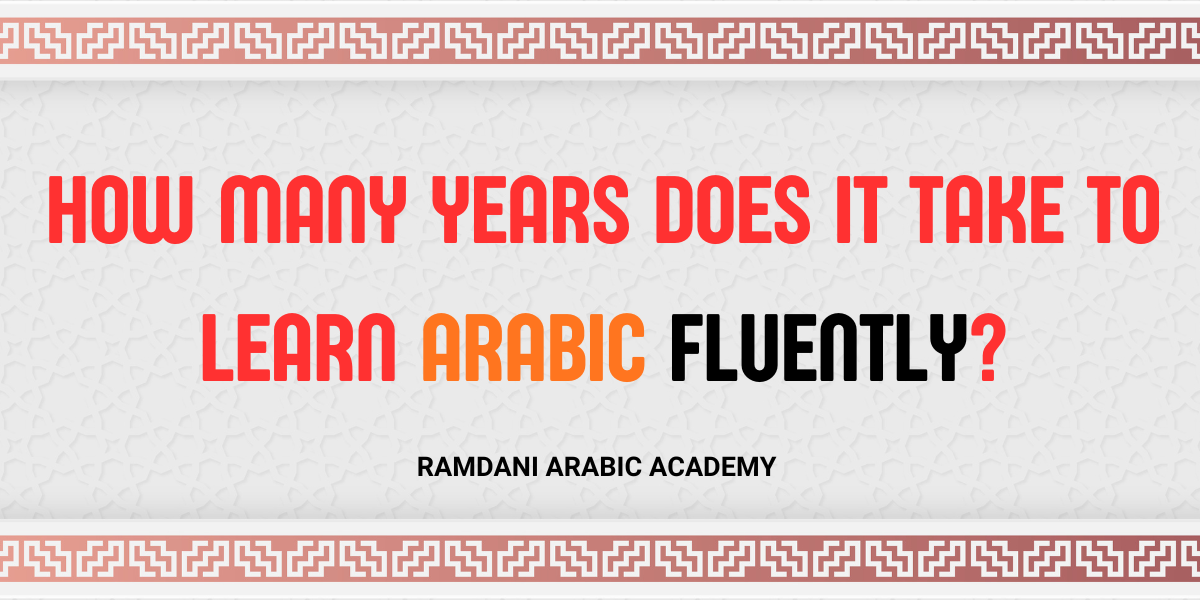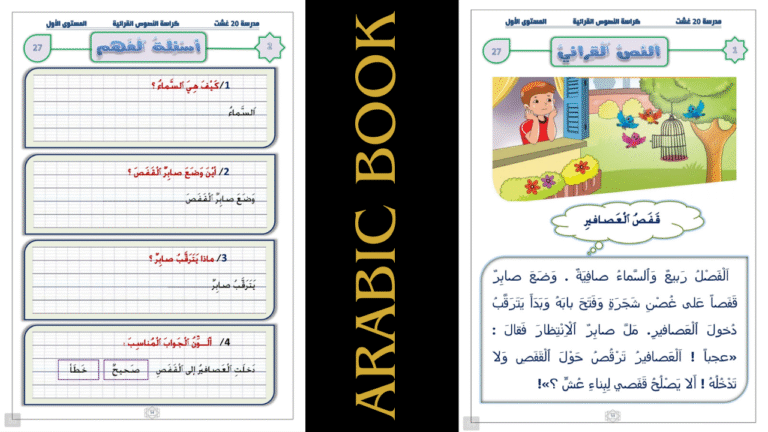How many years does it take to learn Arabic fluently? The Best Adivce
Learning Arabic is one of the most rewarding goals you can set for yourself. It opens doors to a rich culture, a long history, and more than 300 million speakers across over 20 countries. For many learners, though, the first question is always the same. How long will it take before I can speak Arabic fluently?
This question makes sense. Time matters. You want to know how much effort you need to plan for. You want to know if your goal is realistic. And you want to know when you will finally be able to have real conversations, read books, and watch shows without subtitles.
Arabic has a reputation for being hard. It has a different alphabet. Its sounds can be unfamiliar if your first language is English, French, or Spanish. It has grammar rules that don’t look like what you learned in school. And it has many dialects that change from one region to another. All this can make learners feel that fluency might take forever. But the truth is more encouraging than you think.
Fluency is not magic. It is a process. It depends on three main factors. The first is your starting point. Someone who already speaks a language with some overlap, like Persian or Urdu, may need less time. The second is the method you use. A learner who studies every day with good resources and native speakers will progress much faster than someone who only studies once a week. The third is your goal. There is a difference between being able to order food or ask for directions and being able to debate philosophy or write essays.
You should also know that “Arabic” is not one single language. Modern Standard Arabic, or MSA, is used in books, news, and formal writing. Dialects, such as Egyptian, Levantine, or Gulf Arabic, are used in everyday speech. A smart learner often studies both, starting with the form that matches their goals. If you want to travel and make friends, learning a spoken dialect first might be better. If you want to read newspapers or work in media, MSA should be your priority.
This article will help you set clear expectations about how many years you might need to reach fluency. It will break down the learning stages, from beginner to advanced. It will explain how much time per week you need to study at each stage, what skills you should focus on, and which challenges you will face. It will also give you practical advice for speeding up your progress so you don’t waste time on the wrong methods.
By the end, you will know not only how long it might take you to become fluent but also what steps to take to make the journey easier and more enjoyable. You will see that with the right mindset, resources, and community, fluency is not just possible but within reach.

Part 1: How Fluency Is Measured
Before we can talk about how many years it takes to learn Arabic, we need to agree on what “fluency” really means. Many learners confuse fluency with perfection. They think they must speak without any mistakes, understand every word, and sound exactly like a native speaker. This is not fluency.
Fluency means you can use the language naturally in real situations. You can express your thoughts, understand what others say, and keep a conversation going without too much effort. You may still make mistakes, but they don’t stop you from communicating.
One helpful way to measure fluency is the CEFR scale. CEFR stands for Common European Framework of Reference for Languages. It is an international standard used by schools and language programs to describe language ability. It has six main levels:
- A1 (Beginner)
You can introduce yourself, say where you are from, ask and answer simple questions, and use basic phrases. - A2 (Elementary)
You can handle simple, routine tasks. You can talk about your family, your work, and your daily activities in short sentences. - B1 (Lower Intermediate)
You can deal with most situations you might face when traveling. You can describe experiences, plans, and opinions. - B2 (Upper Intermediate)
You can have long conversations on many topics. You can explain your ideas clearly. You can understand TV shows, podcasts, and news with some effort. - C1 (Advanced)
You can express yourself with confidence. You can read and understand long, complex texts. You can write essays or reports without much help. - C2 (Proficiency)
You can use the language almost like an educated native speaker. You understand subtle details, humor, and cultural references.
For most learners, fluency means reaching B2 or C1 level. At this stage, you can live in an Arabic-speaking country, work in Arabic, and make friends without feeling lost. You still have more to learn, but you can function comfortably.
Another way to think about fluency is by skill area. Arabic has four core skills: reading, writing, listening, and speaking. You might reach fluency in one skill faster than the others. For example, some students can read Arabic books well but struggle to speak. Others can have smooth conversations but cannot write formal Arabic.
When you plan your learning journey, decide which skills are most important to you. If you want to work as a translator, focus on reading and writing. If your goal is travel and communication, focus on speaking and listening. This will help you spend your study time wisely.
It is also useful to track your progress with small milestones. For example, you might set a goal to read your first news article without using a dictionary. Or you might aim to have a ten-minute conversation with a native speaker. These small wins keep you motivated and show you that you are getting closer to fluency step by step.
Finally, keep in mind that fluency is personal. Two learners can both be “fluent” but have very different skills. One might speak Egyptian Arabic fluently but not know Modern Standard Arabic. Another might read classical Arabic texts but not understand Moroccan Arabic conversations. Your fluency should match your goals and needs.

Part 2: How Long Each Stage Takes
Once you know what fluency means, the next question is how long it takes to get there. The answer depends on how much time you study each week, the quality of your study, and your exposure to real Arabic outside class.
The Foreign Service Institute (FSI) of the U.S. Department of State groups languages into categories based on difficulty for English speakers. Arabic is in Category IV, which means it is one of the hardest languages for English speakers to learn. According to FSI, it takes about 2200 hours of study to reach a professional working level in Arabic, which is close to B2 or C1.
This number sounds big, but it becomes easier to understand when we break it down. Here is a rough estimate of how long each stage takes if you study around 10 hours per week:
- A1 (Beginner)
100–150 hours
About 3–4 months
You learn the alphabet, sounds, and basic grammar. You can greet people, introduce yourself, and handle simple situations. - A2 (Elementary)
180–200 hours
About 5–6 months
You start using past and future tenses. You can describe your life, your family, and your plans. You can shop, order food, and travel more easily. - B1 (Lower Intermediate)
350–400 hours
About 8–10 months
You can follow slower conversations. You can explain your thoughts in full sentences. You can handle most daily situations without switching back to your native language. - B2 (Upper Intermediate)
500–600 hours
About 12–15 months
You can discuss ideas, understand TV shows and podcasts, and read news articles. You can talk about work, culture, and abstract topics. - C1 (Advanced)
700–800 hours
About 16–18 months
You can participate in debates, write formal essays, and read complex material. You sound confident and natural most of the time.
When you add these hours together, you get around 2200 hours to reach C1. At 10 hours per week, this takes around four years. If you increase your study time to 20 hours per week, you can cut the time in half and reach C1 in about two years.
But not all study hours are equal. Spending two hours memorizing word lists is not the same as two hours speaking with a native teacher. Active practice with real communication moves you forward faster.
Here are some common study patterns and how long they might take you to reach B2 or C1:
- Casual Learner
3–5 hours per week
Progress is slow. You might reach B1 after 3–4 years and B2 after 5–6 years. - Serious Learner
10 hours per week
Good pace. You can reach B2 in about 2.5 years and C1 in 4 years. - Intensive Learner
20+ hours per week
Very fast. You can reach B2 in about 1–1.5 years and C1 in 2–2.5 years. - Immersion Learner
Living in an Arabic-speaking country, studying every day
Fastest path. You can reach B2 in about a year and C1 in 1.5–2 years.
Of course, your progress will not always be smooth. Some stages feel fast, others slow. Many learners hit a “plateau” at B1 or B2 where improvement feels slow. This is normal. The more advanced you get, the more time it takes to see clear progress.
Your background also matters. If you already speak a language related to Arabic, like Hebrew or Persian, you may learn faster. If you already know another foreign language, you may have better study habits and need less time.
The type of Arabic you learn also affects the timeline. Modern Standard Arabic takes time to master because of its grammar and vocabulary. Spoken dialects are usually simpler and can be learned faster, but they do not cover all situations like MSA does. Many students learn both side by side, which adds time but makes them more versatile.
The most important thing is to stay consistent. Ten hours per week, every week, is better than studying 30 hours one week and then stopping for a month. Fluency comes from building habits and not letting your skills fade.

Part 3: Strategies to Learn Faster
The number of years it takes to learn Arabic is not fixed. You can shorten the timeline if you use the right strategies and avoid common mistakes. Many learners waste time on methods that don’t work or focus too much on passive study. Here are proven ways to speed up your progress.
1. Build a Daily Habit
Consistency matters more than intensity. Studying 30 minutes every day is better than four hours once a week. Your brain remembers better when you practice often. Try to make Arabic part of your routine. For example:
- Listen to Arabic news or podcasts every morning
- Review vocabulary during lunch break
- Spend 10 minutes writing a short diary entry at night
Daily contact with Arabic keeps you moving forward and prevents forgetting.
2. Learn the Alphabet Well
Many learners rush through the Arabic alphabet. This causes problems later when reading becomes slow and frustrating. Spend enough time on pronunciation and writing. Practice until you can read simple words quickly. This builds a strong foundation for everything else.
3. Focus on High-Frequency Words
Arabic has a huge vocabulary, but you don’t need to learn every word to communicate. Start with the most common 1000–2000 words. They cover most conversations. Once you can use these words, add more based on your interests and goals.
4. Use Both MSA and Dialect
If your goal is to speak with people, learn a spoken dialect early. It will make conversations easier and more natural. At the same time, study Modern Standard Arabic for reading and writing. A balanced approach helps you avoid the common trap of understanding books but not being able to talk to anyone.
5. Practice Speaking from Day One
Many learners wait too long to start speaking. They fear making mistakes. But speaking early builds confidence and helps you remember vocabulary. You can:
- Find online tutors for conversation practice
- Join language exchange groups
- Record yourself speaking and listen back
Mistakes are part of learning. Native speakers usually appreciate your effort and will help you improve.
6. Use Active Listening
Don’t just watch Arabic TV shows or listen to music passively. Focus on what you hear. Pause and repeat. Try to catch specific words or phrases. Write them down and use them later. Active listening trains your ear and improves pronunciation.
7. Mix Study Methods
Avoid doing only one type of study. Combine reading, writing, listening, and speaking every week. For example:
- Read a short story on Monday
- Watch a YouTube video and write down five new words on Tuesday
- Practice speaking with a tutor on Wednesday
- Write a short paragraph on Thursday
- Review vocabulary and grammar on Friday
This balanced mix keeps learning interesting and builds all skills at the same time.
8. Get Feedback
You learn faster when someone corrects your mistakes. Work with teachers or language partners who can tell you where you need to improve. Don’t just rely on apps or self-study. Personalized feedback saves time and prevents bad habits.
9. Create Immersion at Home
Even if you don’t live in an Arabic-speaking country, you can surround yourself with Arabic. Change your phone settings to Arabic. Follow Arabic accounts on social media. Label objects in your house with Arabic words. These small steps make Arabic part of your daily life.
10. Track Your Progress
Keep a simple log of what you study and what you can do now compared to last month. This helps you stay motivated. For example, write down the first time you understood a full conversation or finished your first Arabic book. Seeing progress keeps you going.
11. Stay Patient
Fluency takes time. Don’t compare yourself to others. Some learners reach B2 in one year, others need three. What matters is that you keep moving forward. Small, steady progress leads to big results.12. Join a Community
Learning alone can feel hard. Join online groups or courses where you can meet other learners. Sharing struggles and successes keeps you motivated and makes learning more fun.

Part 4: Common Challenges and How to Overcome Them
Learning Arabic is rewarding, but it comes with challenges. Understanding these obstacles and knowing how to deal with them will save you time and frustration.
1. The Alphabet and Pronunciation
Arabic has sounds that don’t exist in many other languages. Letters like ع (‘Ayn) or غ (Ghayn) can be difficult to pronounce. Beginners often struggle and feel discouraged.
Solution: Practice daily with a teacher or audio resources. Focus on a few sounds at a time. Use mirrors or record yourself to compare. Over time, your pronunciation will improve. Mistakes are normal and part of learning.
2. Grammar Complexity
Arabic grammar has rules that differ from English or European languages. Verb conjugations, gender agreement, and case endings can be confusing.
Solution: Start with simple grammar patterns and gradually add complexity. Don’t try to master everything at once. Practice grammar in context. For example, write sentences using the new rule instead of just memorizing charts.
3. Diglossia – MSA vs. Dialects
Many learners feel lost between Modern Standard Arabic and regional dialects. TV shows and books use MSA, while everyday conversation uses dialects. Learning one without the other can feel limiting.
Solution: Decide your priority based on your goals. Learn a spoken dialect for communication and MSA for reading and writing. Combining the two takes time but makes you versatile. You will understand more situations and communicate effectively in both formal and casual settings.
4. Vocabulary Overload
Arabic has a vast vocabulary. It is easy to feel overwhelmed, especially when trying to memorize words without context.
Solution: Focus on high-frequency words first. Use them in sentences, conversations, and writing. Gradually expand your vocabulary based on topics you care about. Repetition and active use are more effective than passive memorization.
5. Motivation Dips
Learning a language over years can feel exhausting. Motivation may drop, especially when progress seems slow.
Solution: Break your long-term goal into smaller milestones. Celebrate when you finish your first conversation, read your first article, or write a paragraph. Find a study partner or join a community. Seeing progress, even small steps, keeps motivation alive.
6. Plateaus
Many learners hit a stage where improvement slows, often around B1 or B2. At this point, skills may feel stuck despite continuous study.
Solution: Change your approach. Try immersive experiences, speaking practice with native speakers, or advanced reading materials. Mixing methods and increasing active engagement often pushes you past the plateau.
7. Exposure and Environment
Without regular exposure, skills can fade. Many learners study for months but rarely practice in real-life situations.
Solution: Create immersion opportunities at home. Listen to podcasts, watch shows, or talk with language partners. Even labeling objects in your home in Arabic keeps you connected daily.
8. Cultural Understanding
Language is tied to culture. Understanding social norms, gestures, and expressions is part of fluency. Without cultural context, you may misunderstand or struggle in communication.
Solution: Engage with Arabic media, talk to native speakers, and ask questions about culture. Experiencing the culture alongside language accelerates learning.
9. Time Management
Arabic requires a long-term commitment. Busy schedules can interfere with study and slow progress.
Solution: Plan realistic weekly study schedules. Even short, consistent sessions are effective. Prioritize quality over quantity.
10. Fear of Mistakes
Many learners hesitate to speak because they fear errors. This slows progress significantly.
Solution: Accept that mistakes are natural. Use them as feedback. Speaking regularly with tutors or peers builds confidence. Every conversation is a step closer to fluency.
Overcoming these challenges is part of the journey. Every learner faces them, but the difference is in the approach. With structured practice, realistic goals, and consistent effort, these obstacles become stepping stones rather than roadblocks.

Part 5: Advice, Our Academy
Learning Arabic is a long-term journey, but it is achievable with the right approach. By now, you understand the stages of fluency, the time it takes to progress, and the challenges you might face. The next step is turning this knowledge into action.
Practical Advice for Learners
- Set clear goals
Decide why you want to learn Arabic. Do you want to travel, work, read, or communicate with friends? Your goals will determine which skills to focus on first, whether it’s Modern Standard Arabic, a dialect, or both. - Create a realistic schedule
Consistency beats intensity. Even 30–60 minutes daily is more effective than occasional long sessions. Plan study sessions around your lifestyle so they become a habit, not a chore. - Focus on communication first
Don’t wait to speak until you feel perfect. Use simple sentences, make mistakes, and learn from them. Communication builds confidence and accelerates learning more than memorizing rules alone. - Use multiple resources
Combine textbooks, online courses, videos, podcasts, and language apps. Each tool strengthens a different skill. Active practice, like speaking and writing, is more effective than passive listening or reading alone. - Immerse yourself
Even without living in an Arabic-speaking country, you can create immersion. Listen to Arabic music, watch shows, follow social media in Arabic, and label your environment with Arabic words. Daily exposure makes language learning natural. - Track progress and celebrate milestones
Small wins matter. Track conversations you can hold, articles you can read, or words you’ve learned. Celebrating progress keeps motivation alive and prevents burnout.
About Ramdani Arabic Academy
At Ramdani Arabic Academy, we focus on helping learners reach fluency efficiently. Our courses cover Modern Standard Arabic and popular dialects, with lessons designed for real-life use. We offer:
- Interactive lessons with clear explanations
- Vocabulary and grammar exercises integrated with context
- Speaking and listening practice with native teachers
- Articles and resources to deepen cultural understanding
We believe in practical, action-oriented learning. Every lesson is structured to help learners speak, read, write, and understand Arabic confidently. Our online platform allows learners from anywhere in the world to study at their own pace, with support whenever needed.
The Author
Ramdani Mohamed is the founder of Ramdani Arabic Academy. With years of experience teaching Arabic to international students, Ramdani understands the common struggles learners face. He combines structured methodology with practical guidance, helping students progress steadily while keeping learning engaging. His approach emphasizes real-world communication, cultural awareness, and consistent practice.
Final Thoughts
Arabic fluency is achievable, but it requires time, dedication, and smart strategies. Based on your study habits and goals, reaching B2 or C1 can take anywhere from 2 to 6 years. This may seem long, but each step is meaningful.
Focus on building habits, practicing communication, and learning actively. Overcome challenges one by one. Use resources, engage with the culture, and track your progress. The journey may be long, but fluency brings access to a rich language, culture, and community.
Ramdani Arabic Academy exists to guide you through this journey. With structured lessons, native guidance, and practical exercises, you can accelerate your progress and enjoy the learning process. The right approach makes the difference between struggling for years and reaching fluency confidently and efficiently.
Your path to Arabic fluency starts today. Commit to consistent practice, embrace mistakes, and engage with the language every day. With time, effort, and the right guidance, you will reach your goal and unlock the full richness of Arabic.







